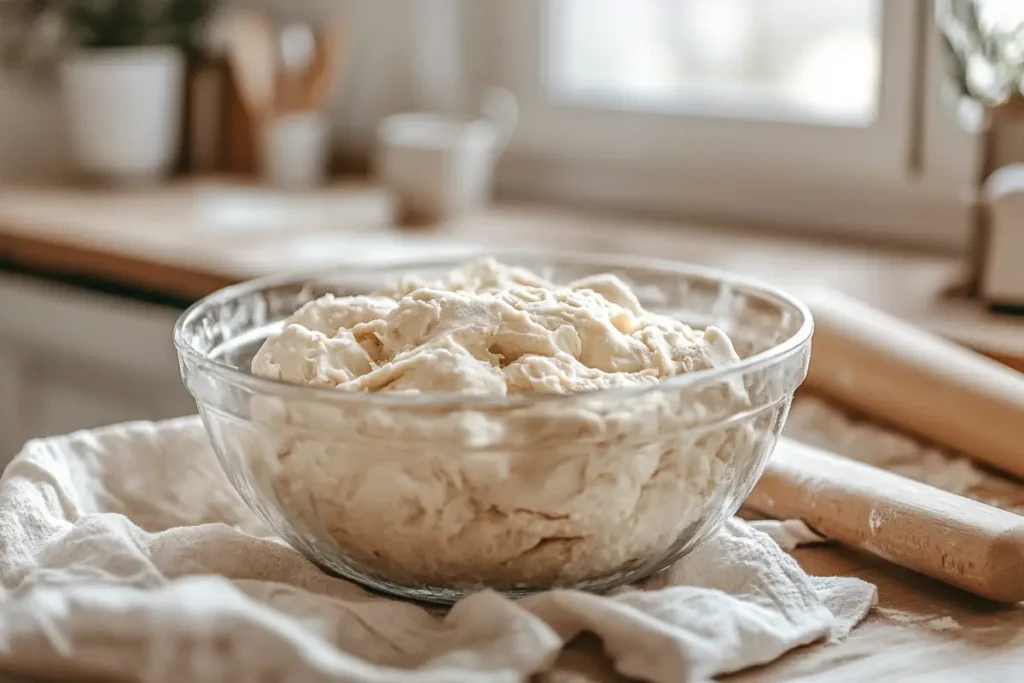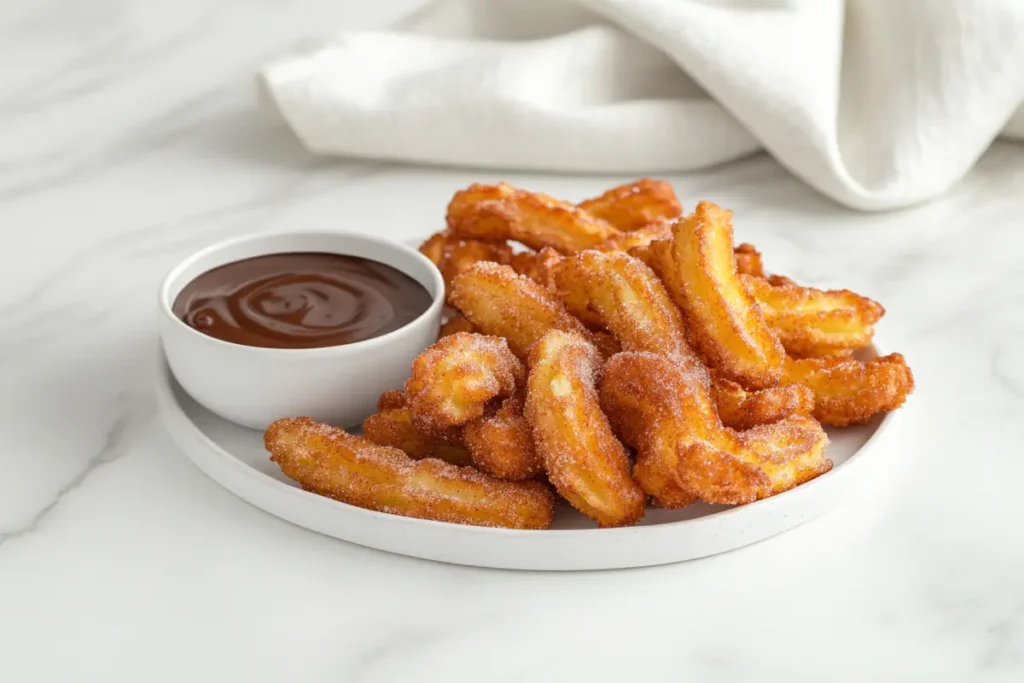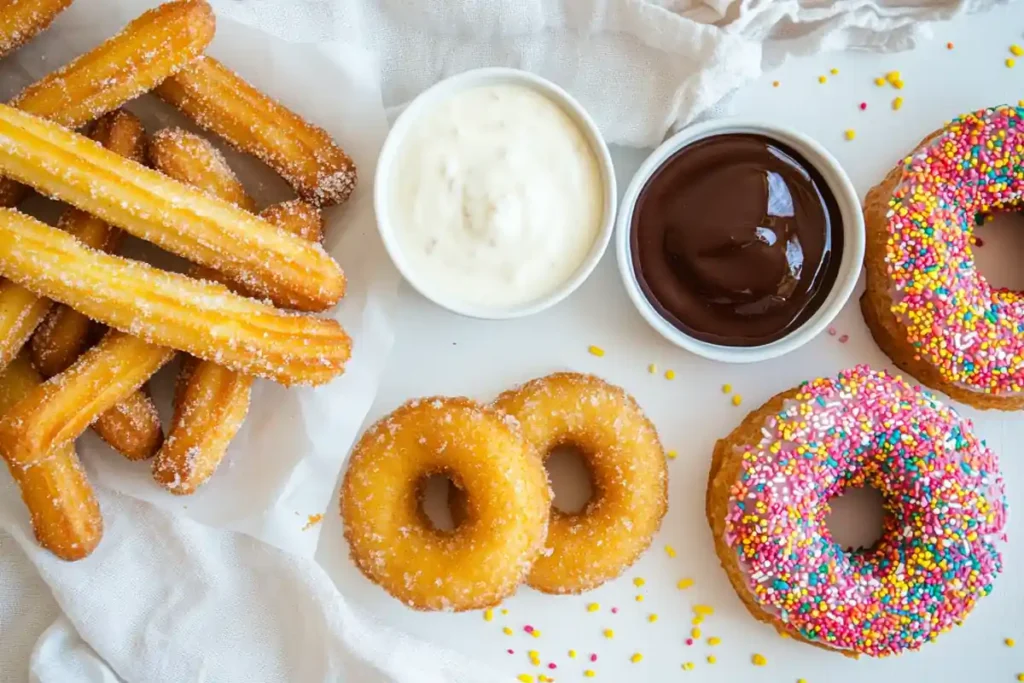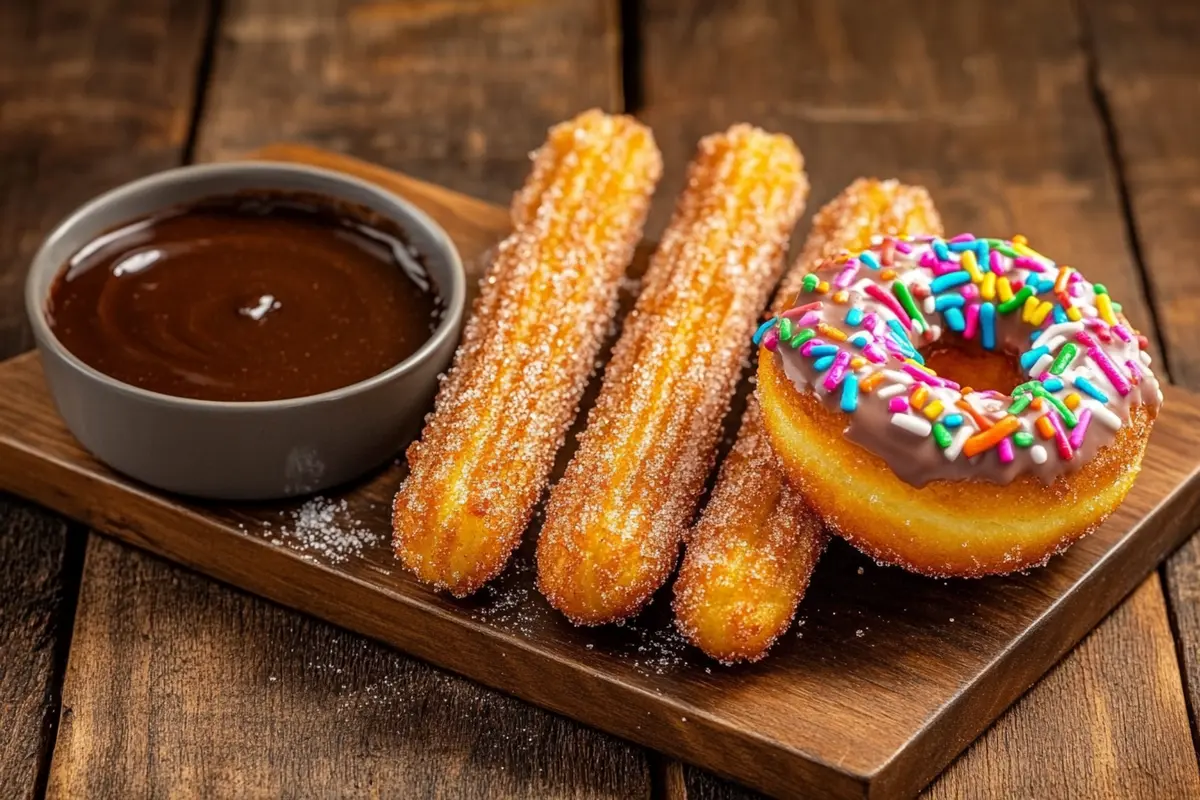Churros and donuts are beloved treats that many people enjoy worldwide. But have you ever wondered whether churro dough is the same as donut dough? While they might look and taste similar at first glance, these two doughs have significant differences and similarities worth exploring. This article dives deep into the textures, ingredients, preparation methods, and unique characteristics of each dough. Let’s unravel the mystery and decide if these fried delights are more alike than they seem!
Introduction to Churro and Donut Dough
What Is Churro Dough?
Churro dough originates from Spanish and Latin American cuisines as a classic pastry base. Chefs make it using choux pastry, a light dough they prepare by cooking butter, water, flour, and eggs together. This process creates a thick, pipeable consistency that crisps beautifully during frying. Instead of relying on yeast or baking powder for leavening, churro dough uses steam to puff up as it cooks. This method gives churros their iconic crunchy exterior and soft, tender interior.
The straightforward ingredients and preparation make churro dough incredibly versatile. Many people pair churros with cinnamon sugar or dip them into chocolate sauce for a delightful treat. Its distinct texture and flavor set it apart from other types of dough, making it a beloved favorite worldwide.
What Is Donut Dough?

In contrast, donut dough is a yeast-based dough that requires time to rise before frying. It typically contains flour, sugar, milk, eggs, butter, and yeast, which work together to create a soft, airy texture. Yeast fermentation plays a critical role in giving donuts their light, fluffy interior.
Unlike churros, donuts come in various shapes and styles, including filled, glazed, or powdered varieties. The yeast and sugar combination also contributes to their slightly sweet, bread-like flavor, which differs significantly from churro dough’s more neutral taste.
Similarities Between Churro and Donut Dough
Churros and donuts share common ground in several ways. Both involve frying sweetened dough and offer an indulgent snack or dessert experience. People often serve them warm, pairing them with sugary coatings or flavorful toppings. Additionally, their versatility allows for countless flavor variations, making them adaptable to different culinary traditions.
However, as the next section reveals, their differences in ingredients, preparation methods, and overall culinary uses set them apart.
Key Differences Between Churro and Donut Doug
Texture and Ingredients
One of the primary distinctions between churro dough and donut dough lies in their ingredients and the resulting texture. Churro dough, made from choux pastry, has a rich, eggy composition, creating a dense yet airy dough. It doesn’t use yeast, relying instead on the moisture from the eggs and butter to expand the dough during frying. This gives churros their signature crispy exterior and soft, almost custard-like interior.
In contrast, donut dough is yeast-leavened, giving it a more bread-like, fluffy texture. The yeast fermentation not only aerates the dough but also imparts a subtle tangy flavor that sets donuts apart from the more neutral-tasting churros. Additionally, donut dough contains sugar and milk, which add sweetness and softness.
The differences in ingredients highlight why churro dough can’t simply substitute for donut dough in recipes—they’re designed for completely distinct textures and flavor profiles.
Preparation Methods
Churro and donut dough differ significantly in preparation and cooking methods. To make churro dough, you cook butter, water, and flour on the stovetop until they form a cohesive paste. After it cools, you beat in eggs to create the final dough. Then, you pipe the dough directly into hot oil and fry it to golden perfection.
In contrast, preparing donut dough involves kneading, proofing, and shaping. Yeast activates the dough, causing it to rise, and then you cut it into rings or shapes. After resting the dough for a second rise, you fry it until it achieves its signature lightness.
These distinct preparation techniques shape their flavors and textures, making each dough unique in the realm of fried desserts.
Cultural and Regional Influences
Churros and donuts both carry rich histories that reflect their regions of origin. In Spain and Latin America, people enjoy churros as a breakfast staple, often pairing them with hot chocolate. Their simple ingredients and quick frying process helped establish churros as a popular street food in these regions.
Donuts, on the other hand, have become a symbol of American culture. Coffee shops frequently serve donuts, offering a wide variety of glazes, fillings, and toppings. Bakers use yeast-based dough to create endless variations, from Boston cream to jelly-filled favorites, making donuts a versatile and beloved treat.
Cultural influences shape not only the preparation of these treats but also their place in culinary traditions worldwide. Despite their differences, both churros and donuts have become beloved desserts across the globe.
Taste and Culinary Applications
Flavor Profiles
Churros and donuts deliver distinctly different flavor experiences. Churros offer a subtle sweetness that cinnamon sugar often enhances. Their fried, eggy choux dough creates a crisp bite and a tender interior. People usually serve churros plain or pair them with dips like chocolate or caramel for extra indulgence.
Donuts, by contrast, pack inherent sweetness thanks to their sugar-rich dough. Their soft, fluffy texture stands in sharp contrast to the dense crispness of churros. Bakers often customize donuts with glazes, frostings, and fillings, creating a seemingly endless variety of flavors.
These flavor differences highlight why churros and donuts each hold a special place in the dessert world.
Common Uses in Recipes
Churro dough shines in simple, straightforward recipes. Its versatility allows it to be adapted into creative treats like churro ice cream bowls or churro cheesecake. Donuts, however, are a staple in bakeries and cafes, offering varieties that range from traditional glazed donuts to gourmet creations with exotic toppings.
While they differ in culinary applications, both doughs inspire creativity, with recipes showcasing their unique textures and flavors. For an example of innovative uses of churros, you can explore a for a delicious twist on this classic dessert.
The Science Behind Churro and Donut Dough
Why Ingredients Matter
When asking Is churro dough the same as donut dough?, the science behind their ingredients provides a clear answer. Churro dough’s foundation lies in choux pastry, which relies on high moisture content. This moisture, combined with heat, creates steam during frying, giving churros their iconic airy yet dense structure. The eggs in churro dough also act as a binding agent, contributing to its elasticity and richness.
In contrast, donut dough depends on yeast or baking powder to rise. The yeast ferments sugars in the dough, producing carbon dioxide, which creates the soft, fluffy texture we love in donuts. Milk and sugar further enhance the tenderness and flavor of donut dough, while butter adds richness.
The interplay of ingredients and the chemical reactions during frying highlight why churro and donut dough behave so differently in the kitchen.
How Cooking Methods Affect Texture
The cooking methods for churro and donut dough are also rooted in science. Churros are piped directly into hot oil, where the high heat quickly seals the dough’s surface. This rapid cooking forms the crispy exterior while the interior stays soft.
On the other hand, donuts require a slower process. After being shaped and proofed, they’re fried at a slightly lower temperature to ensure even cooking. This method allows the yeast to continue expanding the dough during frying, resulting in their signature pillowy texture.
Understanding these processes not only answers the question Is churro dough the same as donut dough? but also explains why these treats are so distinctly different.
Popular Pairings and Serving Suggestions
How to Serve Churros

Churros are incredibly versatile and pair well with a variety of dips and coatings. A classic option is cinnamon sugar, which enhances their crunchy exterior and subtle sweetness. For a more indulgent treat, serve churros with chocolate sauce, caramel, or dulce de leche. They’re also delightful when paired with fresh fruit or whipped cream.
For a creative twist, consider making churro bowls to hold ice cream or fruit toppings. This variation turns the classic snack into a stunning dessert centerpiece.
Creative Donut Toppings and Pairings
Donuts, known for their customizable nature, can be glazed, frosted, or filled with an array of flavors. Maple glaze with crumbled bacon, classic chocolate with sprinkles, or tangy lemon glaze are just a few crowd favorites. Donuts are often paired with coffee, tea, or even milkshakes for a delightful treat.
For a unique experience, experiment with savory donuts. Toppings like cheese, herbs, or even smoked salmon add a surprising twist to the traditional donut.
While both churros and donuts offer countless serving possibilities, their unique textures and flavors ensure they shine in their own right. Whether you’re team churro or team donut, these pairings elevate them to a whole new level.
The Future of Fried Pastries
Innovation in Churro and Donut Recipes
As culinary trends continue to evolve, both churros and donuts are being reimagined in exciting new ways. Food enthusiasts are experimenting with flavored doughs, from matcha-infused churros to chocolate-filled donuts. These innovations not only expand their flavor profiles but also make these desserts more appealing to a wider audience.
With plant-based eating on the rise, chefs are also creating vegan versions of churro and donut dough. By replacing traditional ingredients like eggs and milk with plant-based alternatives, these treats become accessible to more people. While vegan churros closely mimic the original, adapting donut dough can be trickier due to its reliance on yeast for texture.
This creative energy ensures that churros and donuts remain beloved classics while catering to modern tastes and dietary needs.
Cultural Adaptations and Global Popularity
Churros and donuts have transcended their origins to become global favorites. In Asia, for instance, matcha-flavored churros are a popular street food, while mochi donuts, made with glutinous rice flour, provide a chewy twist on the classic recipe. These cultural adaptations highlight the versatility of both doughs.
Despite their international popularity, some questions persist—Is churro dough the same as donut dough? Exploring these differences helps preserve the culinary identity of each treat while celebrating their shared appeal as indulgent fried desserts.
Final Thoughts and Recipe Inspiration

Reflections on the Comparison
As we’ve explored throughout this article, the question Is churro dough the same as donut dough? reveals fascinating differences between these iconic treats. From ingredients to preparation, churro dough’s choux pastry roots distinguish it from donut dough’s yeast-based composition. Their differences don’t just stop at texture and taste; they extend to cultural significance and culinary uses.
Yet, their similarities can’t be ignored. Both are fried, sweet, and adored by millions. Whether you’re a fan of churros’ crispy exteriors or donuts’ pillowy interiors, there’s no denying their shared status as comfort food.
Recipe Recommendations for Churro and Donut Fans
If you’re inspired to try your hand at making these treats, plenty of recipes await! For churro enthusiasts, experiment with recipes like cinnamon sugar churros or churro ice cream bowls. Donut lovers can explore classic yeast donuts or unique twists like maple bacon donuts.
For a creative combination of both, why not try churro donuts? These hybrids blend the crispness of churros with the ring-shaped appeal of donuts. Check out our Churro Cheesecake Recipe for more inspiration and dessert ideas!
In the end, whether you choose churros, donuts, or both, one thing’s certain—they’re all delicious ways to satisfy your sweet tooth.
Conclusion
Summarizing Similarities and Differences
In summary, while churro dough and donut dough may seem similar at first glance, they’re quite different in composition, preparation, and flavor. Churro dough, made from choux pastry, delivers a crispy, dense texture, while donut dough, enriched with yeast, offers a light and airy bite. Both are beloved fried treats, yet they cater to distinct preferences and culinary traditions.
Choosing Between Churros and Donuts: What to Consider
When deciding between churros and donuts, consider the occasion and your taste preferences. Churros are ideal for quick, no-fuss recipes and pair wonderfully with dipping sauces, making them perfect for breakfast or snacks. Donuts, with their sweet dough and endless variety of glazes and fillings, shine as a versatile desser
FAQs Section
What Dough Are Churros Made Of?
Churro dough uses choux pastry, a type of dough made by combining butter, water, flour, and eggs. To prepare it, you cook the mixture on the stovetop before piping it into hot oil for frying. Unlike donut dough, churro dough relies on steam for its airy interior and crispy exterior rather than using yeast or other leavening agents.
Does a Churro Count as a Donut?
Churros and donuts may share similarities as fried dough treats, but they are not the same. Churros use choux pastry, while donuts typically rely on a yeast-based or cake-style dough. These differences in ingredients, preparation methods, and texture clearly set churros and donuts apart as distinct desserts.
What’s the Difference Between Cinnamon Roll Dough and Donut Dough?
Cinnamon roll dough stands out for its richness and yeast base, which you roll out, fill with cinnamon and sugar, and bake to perfection. Donut dough, while also often yeast-based, takes a different path—you fry it instead of baking it, resulting in a lighter and airier texture. Donut dough also contains more sugar for sweetness, whereas cinnamon roll dough focuses on its flavorful filling.
What Dough Are Donuts Made Of?
Donuts feature either a yeast-based dough or a cake-style batter. When making yeast donuts, you combine flour, sugar, yeast, milk, eggs, and butter to create a soft, fluffy texture. For cake donuts, you use a baking powder-leavened batter, which results in a denser, crumblier texture. Both types of donuts are fried to a golden crisp and topped with glazes, sugar, or fillings to enhance their deliciousness.

